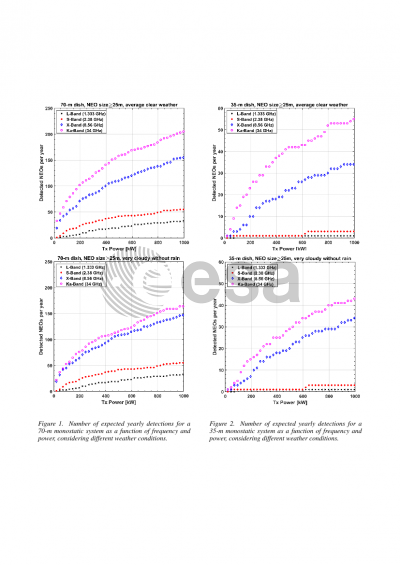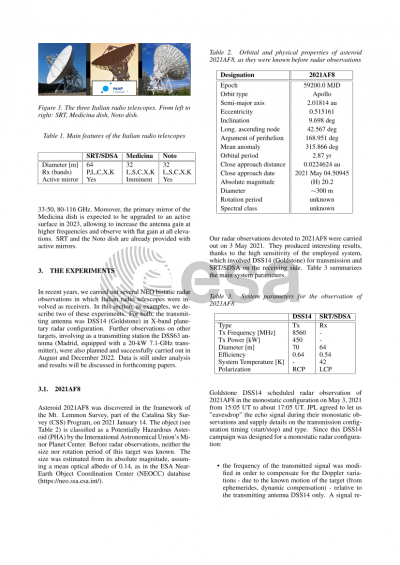Document details

Abstract
In this work, we present preliminary results of NEO radar observations carried out by Italian radio telescopes in the framework of the ESA project “NEO observation concepts for radar systems”, in which INAF, SpaceDyS, and the University of Helsinki are involved. It is aimed to derive the functional requirements of a radar system, evaluate the available European assets to perform NEO radar observations, and carry out some test radar campaigns.
In the framework of this project, we carried out observations of asteroids 2021 AF8, 2016 AJ193, and 4660 Nereus, which also served as test beds for the post-processing tools that were developed.
The experiment devoted to 2021 AF8 was carried out on 3 May 2021. It produced interesting results, thanks to the high sensitivity of the employed system, which involved DSS-14 (Goldstone) for transmission and SRT/SDSA on the receiving side. Spectra with sub-Hz resolution were achieved, thanks to the employment of the SDSA X-band devices. Measurements of the Doppler broadening yielded an estimate of its rotation period (about 8.5 hours, assuming an equatorial view).
The radar observation of 4660 Nereus, carried out in December 2021 by the bistatic radar system DSS14-Medicina, allowed us to confirm the high value of the circular polarization ratio, c=0.82 ± 0.05, typical of the E-class spectral type asteroids such as Nereus. This value is consistent with the measurements performed at Arecibo and Goldstone.
Further observations, involving as a transmitting station the DSS63 antenna (Madrid, equipped with a 20-kW 7.1-GHz transmitter), are being planned.
Besides the planning and execution of radar observations, we developed specific software to process the acquired data. We also carried out the performance analysis of a possible European planetary radar system. Instrumental features, as much as issues like the impact of weather conditions on signal propagation at different radio frequencies, were considered. The European radio astronomical dishes, although employed only as receivers (in bistatic or multistatic configurations) and for a limited amount of time (due to their primary focus on other studies) might provide a significant contribution to the constitution of a European network for NEO monitoring and studies, if a transmitting antenna - equipped with a high-power transmitter - were made available.
Preview









